China-Laos Railway shortens travel time, provides modern passenger services
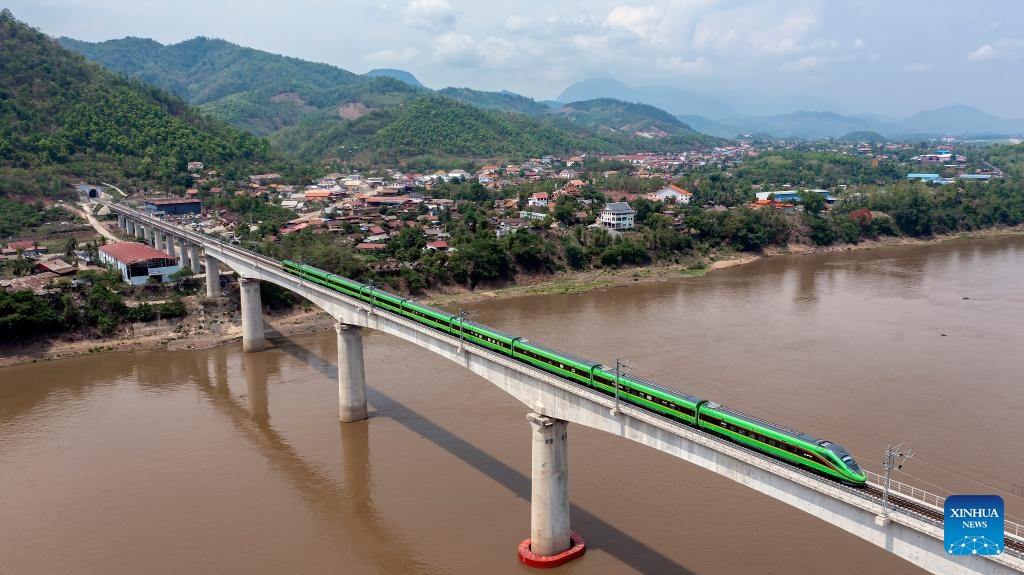
A train drives on the China-Laos Railway's Luang Prabang cross-Mekong River super major bridge in Laos, May 28, 2023. (Xinhua/Chen Chang)
It was early morning and train attendants were making their final preparations onboard train D887 before its departure from Kunming, capital city of Yunnan province in southwest China. At 8:08 a.m., the train left Kunming South Railway Station, heading for Vientiane, capital of Laos.
The 1,035-km-long China-Laos Railway is an iconic project of the high-quality joint construction of the Belt and Road Initiative (BRI) by China and Laos.
Zhao Yingjing, the chief conductor, walked through the carriages helping passengers look for their seats and stow their luggage. Zhao, who was born in Yunnan, has been a member of China Railway Kunming Bureau Group Co., Ltd. for 11 years. In addition to her native Chinese, she can also speak Lao, Thai and English.
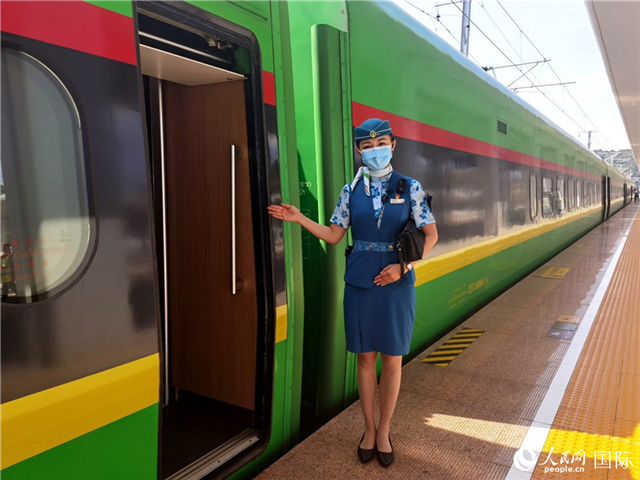
Zhao Yingjing stands outside a carriage of the Fuxing international passenger train on the China-Laos Railway. (People’s Daily Online/Du Mingming)
Zhao's grandfather served as a soldier in the Railway Engineering Corps of the Chinese People’s Liberation Army, while her mother worked as a train attendant. Inspired by her family's connection to the railway, Zhao set her sights on becoming a member of the crew on trains running along the China-Laos Railway, which began construction in 2016.
On Dec. 3, 2021, when the China-Laos railway began operation, Zhao achieved her dream of becoming the chief conductor of the inaugural train on this historic route.
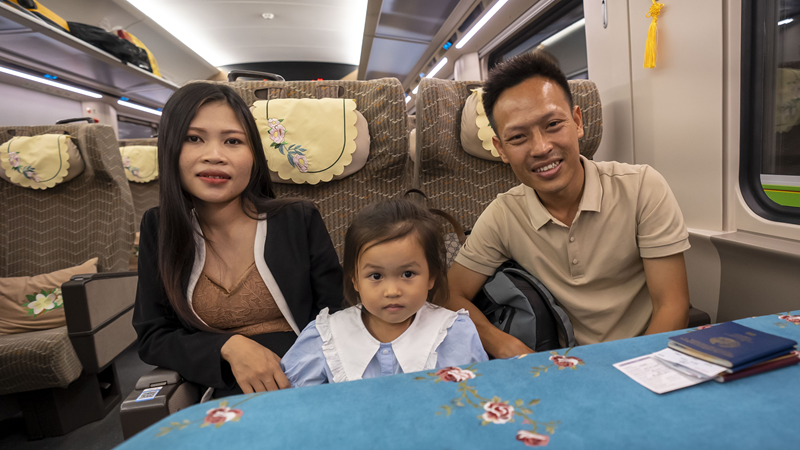
Duan Mingkun (first from right) and his family. (People's Daily Online/Xu Zheng)
34 year-old Duan Mingkun and his family embarked on their journey from the train station in Pu'er city, Yunnan. Duan had previously studied the Lao language whilst at university and currently holds a position at a Chinese company in Savannakhet province, Laos. It was during his time working for this company that he met a Lao woman, and their feelings grew into a loving relationship. Today, they are happily married and have a 4-year-old daughter together.
"Before the China-Laos Railway opened to traffic, whenever I wanted to go home, I had to take a detour through Vientiane. I would catch a flight from there, but since the flights usually departed in the morning, I had to arrive in Vientiane a day prior. Once I landed in Kunming, I still had to endure a four to five-hour car journey to finally reach home," recalled Duan.
However, since the commencement of the China-Laos international passenger train service in April 2023, travel times have been greatly reduced and the experience, as a whole, has been improved. The journey from Vientiane to Pu’er now takes a mere seven hours.
At noon, the train made a stop at Mohan station, the final station in China before crossing into Laos.
International passengers on the China-Laos Railway experienced the unique process of going through customs and immigration checks twice during their journey. On reaching Mohan, the Chinese border station, travelers had to complete exit procedures. Similarly, on arrival at Boten, the border station in Laos, passengers underwent entry procedures to officially enter the country.
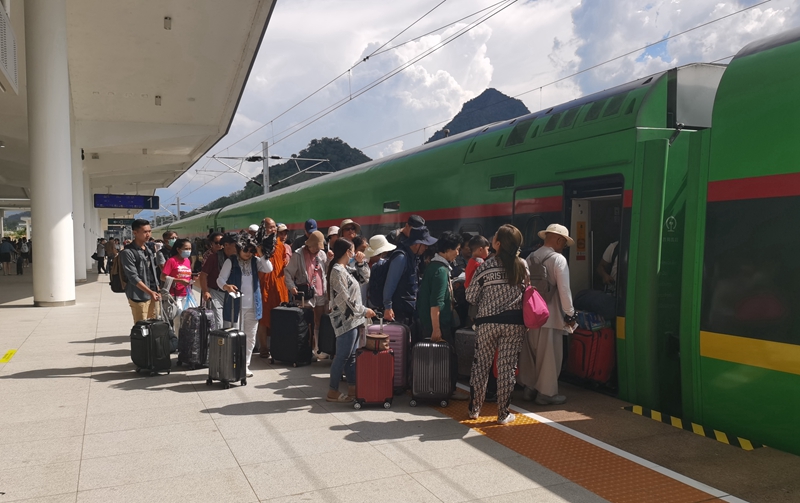
Passengers board a train at the Luang Prabang Railway Station in Laos. (People's Daily Online/Du Mingming)
July 22 marked the 100th day since operations on the China-Laos railways began. Since then, an impressive 200 train services – carrying 41,735 passengers from 49 different countries and regions – have been provided by the railway.
24-year-old Phuang Soulapheang, from Luang Prabang, is a customs inspector at the Boten border station.
"I majored in business management as a university student. I worked at a hotel after graduation from university. After I saw the recruitment information provided by the Laos-China Railway Co., Ltd., I applied for the job," the man said. "Railway transport is an emerging industry in Laos and it will surely enjoy a bright future," he expressed.
During his training and internship period, Phuang performed exceptionally well and received special rewards from the company. When talking about his work, he often mentioned his Chinese mentor.
"Before the construction of the China-Laos Railway, Laos had almost no railways, and there were no corresponding expressions for many railway terms in the Lao language, such as 'rail'. The Chinese mentor patiently taught me bit by bit, and I gradually became proficient until I can handle things independently now," Phuang said. He chose to work at the Boten border station because it is closer to China.
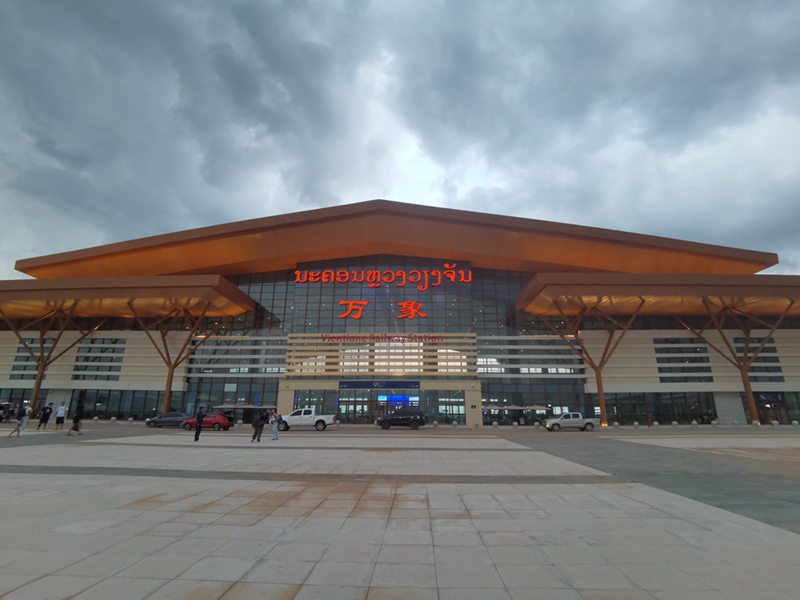
Photo shows the Vientiane Railway Station in Laos. (People's Daily Online/Du Mingming)
Thongsawan is a Lao student studying in Yunnan, who was traveling with his classmates.
"In the past, it would take two to three days by car to travel from Vientiane to Kunming, with at least three transfers along the way. Now, taking the train from Laos to China is much more convenient. We don't have to spend the night on the train and can enjoy the scenery along the way," he said.
Zachariah and his wife Madeline from Louisiana, the U.S., were visiting Laos for the second time. As they entered the train compartment, both of them had surprised expressions on their faces. "We never expected to be able to ride such a modern train in Laos. The seats are very comfortable," Madeline told People’s Daily.
"It's truly admirable to see a modern railway built in such a complex terrain!" Zachariah said.
The couple had planned a detailed itinerary for their two-week travel in Southeast Asia, with their next destination being Vang Vieng. "Being able to ride such a fast train has saved us a lot of time," Zachariah added.
At the Vang Vieng station, a group of passengers disembarked while new passengers filled the train.
Shortly after the train pulled away from Vang Vieng, it began to rain outside. Yet, inside the carriages, passengers were treated by the melody of a familiar Chinese song. It was being sung by Jestar, a Thai traveler who had been studying Chinese for 10 years and knew many Chinese songs. This was his first trip to Laos. "I have traveled to many places in China and often took high-speed trains there. Thanks to China's efforts in promoting connectivity, Southeast Asia now has such modern trains," he said.
Later that evening, the train arrived at its final destination of Vientiane. Crowds of passengers walked out of the station and entered the brightly lit city. The 1,035-kilometer-long China-Laos Railway has tightly linked the two countries, further enhancing the well-being of the people of both nations and the region as a whole.
Photos
Related Stories
- China's BRI-linked youth program benefits 19 countries
- BRI boosts integration, sustainable growth: Ethiopian PM
- Digital economy forum of 3rd BRF held in Beijing
- Belt and Road thematic forum on people-to-people bonds held in Beijing
- Uzbek president vows to expand green cooperation under BRI
- Thematic forum of 3rd BRF on think tank exchanges held in Beijing
- Chinese VP calls for jointly building Green Silk Road
Copyright © 2023 People's Daily Online. All Rights Reserved.









